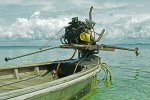bowler
Well-Known Member
Hello all,
Firstly, congrats to all you English boaters who are back on the water. Sadly here in N.Ireland we are still housebound but hopefully that will change soon.
I have a Fairline Corniche 31 with twin TAMD41s. Assuming one engine failed, it is possible to continue on the second. However, I have found that a significant amount of steerage is lost when using a single engine, particularly when moving from a stationary position. Depending on which engine, the boat heads immediately for port or starboard until enough speed it built up that the steering eventually has some effect and the boat straightens out and I can regain reasonable control.
Where the boat is berthed (on a river), there are narrow channels (none of which are straight) into lock gates that we have to navigate before we can get to sea. In a scenario where an engine failed on one of these narrow channels I can't imagine being able to continue on a single engine without losing enough control to keep the boat off the shore, or the shallows, on either side. At least initially.
Any thoughts on how disaster could be avoided in this situation? Could a small portable trolling motor be mounted on the swim platform to provide even steering, or counteract the initial push created by the one remaining prop and keep the boat straight? Does one exist with enough grunt? Obviously wind and tide are a factor as well.
Hopefully this never happens, but if it did I 'd like to have a plan in mind.
All thoughts welcome.
D
Firstly, congrats to all you English boaters who are back on the water. Sadly here in N.Ireland we are still housebound but hopefully that will change soon.
I have a Fairline Corniche 31 with twin TAMD41s. Assuming one engine failed, it is possible to continue on the second. However, I have found that a significant amount of steerage is lost when using a single engine, particularly when moving from a stationary position. Depending on which engine, the boat heads immediately for port or starboard until enough speed it built up that the steering eventually has some effect and the boat straightens out and I can regain reasonable control.
Where the boat is berthed (on a river), there are narrow channels (none of which are straight) into lock gates that we have to navigate before we can get to sea. In a scenario where an engine failed on one of these narrow channels I can't imagine being able to continue on a single engine without losing enough control to keep the boat off the shore, or the shallows, on either side. At least initially.
Any thoughts on how disaster could be avoided in this situation? Could a small portable trolling motor be mounted on the swim platform to provide even steering, or counteract the initial push created by the one remaining prop and keep the boat straight? Does one exist with enough grunt? Obviously wind and tide are a factor as well.
Hopefully this never happens, but if it did I 'd like to have a plan in mind.
All thoughts welcome.
D

